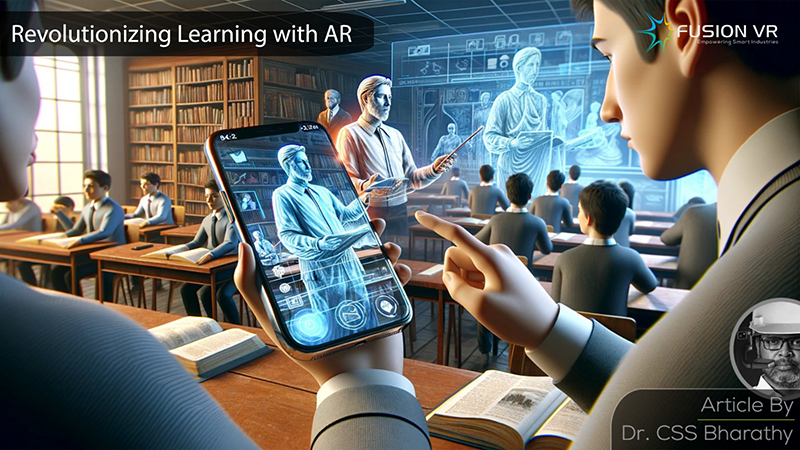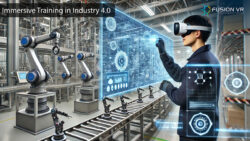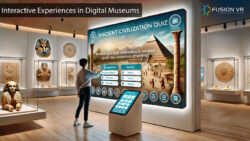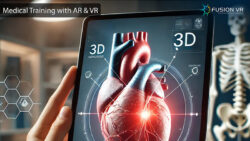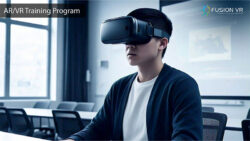Augmented Reality (AR) has rapidly emerged as a transformative technology particularly in the field of education and training. It is revolutionizing the way we design courses and train individuals for securing employment and acquiring competencies across various industries. AR is immersive, interactive, and comes armed with context-rich capabilities. This powerful technology could be an enabler for institutions and corporations to witness a paradigm shift in the training landscape by offering highly realistic simulations and customized learning experiences. AR is on the threshold of significant advancements, which will further impact training approaches and methodologies.
AR primarily creates immersive and interactive experiences by overlaying digitally created information on the reality that is around us as we view it through the lens of the devices we use. This can be a smartphone, tablet or a specially designed wearable device. The enhancements, simulations and added information enable learners to develop a quick understanding of the learning matter and also achieve remarkable retention of that knowledge. In such AR powered learning encounters, students gain a deeper understanding of complex concepts. The AR application also provides immediate feedback, guidance and suggestions for improvement to achieve the desired learning outcomes. The benefit of immediate feedback ensures quick recognition of gaps and encourages learners to fix them in real time. Such an approach helps achieve skills quicker than conventional learning methods.
The simulated and gamified learning approach using AR makes learning an enjoyable experience. The experience is motivating and encouraging learners to push themselves to gain badges and rewards. The advantage of simulation is that it delivers real training without impacting anything real in the workplace. The cost impact of failures is zero and allows the trainer to hit reset and resume their training. Moreover, the training can be adjusted to a pace that is comfortable and personalized for the trainee. AR training does not present a one size fits all approach and every learner is empowered to customize their own approach. AR also provides the option of enabling remote support from anywhere in the world to help learners understand and execute a task. This approach using AR enhances engagement and makes learning a more enjoyable experience and also saving a lot of time and money.
The global corporate training market was estimated to be USD 145 billion in 2022 with a projection to grow at a CAGR of 9.57% reaching USD 251 billion by 2028. The workplace training industry is supporting the business world to train and upskill employees with the competencies needed to deliver on their corporate objectives. Effective high quality training leads to superior performance, increased productivity and higher employee retention. Augmented reality with all its inherent advantages is poised to revolutionize this industry.
The manufacturing industry relies a lot on training and development of its employees. The cost of inadequate and ineffective training leads to unplanned events, injuries, customer quality complaints and unit downtime which results in losses of several million dollars in revenue. Human error is a leading cause of this and proper training is the most prescribed remedy to avoid this. But training is not an easy endeavor in the manufacturing sector as it consumes a lot of time and highly qualified resources to develop the competencies needed to deliver safe and efficient operations.
Many new hires to the industry are well qualified, but do not enter the workplace with the skills needed. These skills are not taught at colleges and universities anywhere in the world, but need to be acquired through on the job training. Take the refining and petrochemical industry where it takes more than six months of training and evaluations to ensure the trainee can independently conduct the operations. With AR, this process is speeded up as technology helps to understand the concept, work processes, protocols, work procedures etc. more effectively and within a relatively short duration. This type of training delivers results without impacting the day to day operations of the plant or the safety of plant personnel.
Augmented reality is also used to deliver remote training and support. Wearables equipped with a camera, display and high speed connectivity are worn by technicians, operators and engineers that relay expert guidance directly to the user as he/she conducts the activity. It is the same as having a guide by your side, seeing the same things as you see and guiding you to deliver the expected outcomes. This sort of remote support not only trains personnel, it also helps them develop the skills and competencies needed. The training approach with a subject matter expert even if they are far away is made possible with AR, something that was inconceivable decades ago, but made possible due to advances in technology and connectivity.
Medical training is another area where AR applications are highly sought after. Surgical expertise is acquired through hands-on training under the guidance of experienced surgeons. The stakes are high in surgical situations and therefore the importance of executing surgical procedures with high precision and zero error to ensure successful patient outcomes. To assist young residents and surgeons develop confidence and competence, AR training courses have been developed. These courses emphasize a strong foundation in the fundamentals needed and incorporate simulation exercises that enable doctors to understand the finer details of the procedure and maximize their skills with adequate practice. These simulations done on digital models provide the much needed confidence and identify the potential for human error that could emerge when operating a real patient.
Support is also available during surgery with AR powered wearables such as AR goggles. The surgeon dons these goggles which overlays the key steps from the simulation onto the real patient. The application guides the surgeon through each step and prevents errors from happening with voice over instructions and reminders to stick to the plan of action. This on the job training is highly useful to prevent errors and restore patients to good health quickly. Armed with this knowledge and practice from these surgical training courses, doctors can conduct operations with highest confidence and skill. The Cleveland Clinic at Case Western Reserve University, for example, teaches human anatomy to students utilizing AR 3D human models. This has resulted in the reduced need and use of human cadavers for learning about human anatomy. This also results in cost savings and enables multiple sessions of practice at no extra cost.
Training courses that use AR need developers trained to use AR. As the demand for AR applications grows, there is a corresponding need to churn out well qualified augmented reality developers as well with cutting edge AR development courses and AR certification courses. Finding a good augmented reality training course is not a huge challenge as long as you know where to look for it. Since the growth market for AR VR engineers is high, there are several fly by night operators who present courses that may not be well structured or supported with qualified faculty. Fusion VR is a company that has delivered several AR VR both domestically and internationally has partnered with ARK Info Solutions to deliver the Industry Academic Alliance Program (IAAP) to train and equip today’s engineers and professionals with the skills needed by the industry. This awareness is there because of Fusion VR’s deep experience and it has helped design AR VR courses to deliver the skills that the industry actually needs for creating AR VR apps. This also helps them achieve quicker placement in reputed organizations soon after completion. I encourage you to explore our website if you are interested as a trainer or as a learner. Reach out to us and share your feedback.

